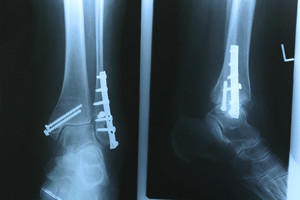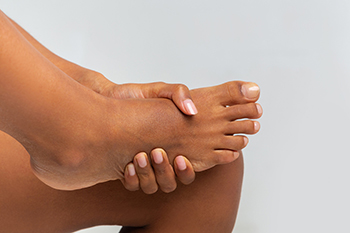Connect With Us
Blog
Items filtered by date: June 2024
Why Live with Pain and Numbness in Your Feet?
Types of Ankle Fractures
 Foot and ankle trauma is a prevalent issue, especially ankle injuries, which can significantly affect mobility. Among the common types of ankle fractures are isolated fibular fractures and Danis-Weber fractures, classified into types A, B, and C. An isolated fibular fracture involves the fibula and is typically less severe. Danis-Weber type A fractures occur below the ligament complex, a group of ligaments that connect the tibia, or shinbone, and the fibula, the smaller bone next to the tibia, just above the ankle joint. A type B fracture is at the level of the ligament complex, and a type C fracture is above the ligament complex, often accompanied by an injury in this area. Treatment for these fractures ranges from immobilization with a cast or brace for less severe cases to surgical intervention for more complex fractures. Potential complications can include chronic pain, instability, and post-traumatic arthritis, which can impede recovery and long-term function. Given the complexities and potential for complications, if you have an ankle fracture, it is suggested that you schedule an appointment with a podiatrist for an accurate diagnosis, effective treatment, and optimal recovery.
Foot and ankle trauma is a prevalent issue, especially ankle injuries, which can significantly affect mobility. Among the common types of ankle fractures are isolated fibular fractures and Danis-Weber fractures, classified into types A, B, and C. An isolated fibular fracture involves the fibula and is typically less severe. Danis-Weber type A fractures occur below the ligament complex, a group of ligaments that connect the tibia, or shinbone, and the fibula, the smaller bone next to the tibia, just above the ankle joint. A type B fracture is at the level of the ligament complex, and a type C fracture is above the ligament complex, often accompanied by an injury in this area. Treatment for these fractures ranges from immobilization with a cast or brace for less severe cases to surgical intervention for more complex fractures. Potential complications can include chronic pain, instability, and post-traumatic arthritis, which can impede recovery and long-term function. Given the complexities and potential for complications, if you have an ankle fracture, it is suggested that you schedule an appointment with a podiatrist for an accurate diagnosis, effective treatment, and optimal recovery.
Broken ankles need immediate treatment. If you are seeking treatment, contact Jeffrey L. Bober, DPM from Maryland. Our doctor can provide the care you need to keep you pain-free and on your feet.
Broken Ankles
A broken ankle is experienced when a person fractures their tibia or fibula in the lower leg and ankle area. Both of these bones are attached at the bottom of the leg and combine to form what we know to be our ankle.
When a physician is referring to a break of the ankle, he or she is usually referring to a break in the area where the tibia and fibula are joined to create our ankle joint. Ankles are more prone to fractures because the ankle is an area that suffers a lot of pressure and stress. There are some obvious signs when a person experiences a fractured ankle, and the following symptoms may be present.
Symptoms of a Fractured Ankle
- Excessive pain when the area is touched or when any pressure is placed on the ankle
- Swelling around the area
- Bruising of the area
- Area appears to be deformed
If you suspect an ankle fracture, it is recommended to seek treatment as soon as possible. The sooner you have your podiatrist diagnose the fracture, the quicker you’ll be on the way towards recovery.
If you have any questions, please feel free to contact our office located in Glen Burnie, MD . We offer the newest diagnostic and treatment technologies for all your foot care needs.
Causes of Chronic Foot Pain

Chronic foot pain is more than just a nuisance, It can significantly impact your daily life and mobility. Trauma, whether from a sudden injury or repetitive strain, can lead to a variety of foot issues including sprains, strains, and stress fractures. Overuse injuries, common among athletes and those with physically demanding jobs, can result in conditions like Achilles tendonitis and plantar fasciitis. Biomechanical factors, such as improper footwear or structural misalignment, can also contribute to chronic foot pain by causing conditions like bunions, corns, and neuromas. Underlying medical conditions, such as diabetes, gout, and peripheral neuropathy, can result in foot pain and increase the risk of complications. Additionally, infections like athlete's foot or ingrown toenails can cause persistent discomfort if not properly treated. If chronic foot pain is limiting your mobility and interfering with daily activities, it is suggested that you make an appointment with a podiatrist for an exam and treatment.
Foot Pain
Foot pain can be extremely painful and debilitating. If you have a foot pain, consult with Jeffrey L. Bober, DPM from Maryland. Our doctor will assess your condition and provide you with quality foot and ankle treatment.
Causes
Foot pain is a very broad condition that could be caused by one or more ailments. The most common include:
- Bunions
- Hammertoes
- Plantar Fasciitis
- Bone Spurs
- Corns
- Tarsal Tunnel Syndrome
- Ingrown Toenails
- Arthritis (such as Gout, Rheumatoid, and Osteoarthritis)
- Flat Feet
- Injury (from stress fractures, broken toe, foot, ankle, Achilles tendon ruptures, and sprains)
- And more
Diagnosis
To figure out the cause of foot pain, podiatrists utilize several different methods. This can range from simple visual inspections and sensation tests to X-rays and MRI scans. Prior medical history, family medical history, and any recent physical traumatic events will all be taken into consideration for a proper diagnosis.
Treatment
Treatment depends upon the cause of the foot pain. Whether it is resting, staying off the foot, or having surgery; podiatrists have a number of treatment options available for foot pain.
If you have any questions, please feel free to contact our office located in Glen Burnie, MD . We offer the newest diagnostic and treatment technologies for all your foot care needs.
Choosing the Right Running Shoes
 Selecting the right running shoes is important for both performance and injury prevention. Good running shoes should provide adequate support, cushioning, stability, and proper fit. Look for shoes that match your foot type, whether you have flat feet, high arches, or neutral arches. Additionally, consider the terrain you will be running on and choose shoes with appropriate traction and durability. When buying running shoes, try them on in the afternoon when your feet are slightly swollen, ensuring a proper fit. Leave about a thumb's width between your longest toe and the end of the shoe. Transition gradually from old to new shoes to allow your feet to adjust to the differences in support and cushioning. If you are looking for well-fitting running shoes, it is suggested that you visit a podiatrist for personalized guidance on selecting shoes and to address any specific foot concerns. This foot doctor can assess your gait, foot structure, and biomechanics to recommend the most suitable shoes for your needs, helping you enjoy a safe and comfortable running experience.
Selecting the right running shoes is important for both performance and injury prevention. Good running shoes should provide adequate support, cushioning, stability, and proper fit. Look for shoes that match your foot type, whether you have flat feet, high arches, or neutral arches. Additionally, consider the terrain you will be running on and choose shoes with appropriate traction and durability. When buying running shoes, try them on in the afternoon when your feet are slightly swollen, ensuring a proper fit. Leave about a thumb's width between your longest toe and the end of the shoe. Transition gradually from old to new shoes to allow your feet to adjust to the differences in support and cushioning. If you are looking for well-fitting running shoes, it is suggested that you visit a podiatrist for personalized guidance on selecting shoes and to address any specific foot concerns. This foot doctor can assess your gait, foot structure, and biomechanics to recommend the most suitable shoes for your needs, helping you enjoy a safe and comfortable running experience.
If you are a runner, wearing the right running shoe is essential. For more information, contact Jeffrey L. Bober, DPM from Maryland. Our doctor can provide the care you need to keep you pain-free and on your feet.
Choosing the Right Running Shoe for Your Foot Type
To increase performance and avoid the risk of injury, it is important to choose the right running shoe based on your foot type. The general design of running shoes revolves around pronation, which is how the ankle rolls from outside to inside when the foot strikes the ground.
- Neutral runners are able to choose from a wide variety of shoes, including minimalist shoes or even going barefoot.
- Runners who overpronate, or experience an over-abundance of ankle rolling, should choose shoes that provide extra motion control and stability.
- Runners who underpronate, or supinate, have feet that have high arches and lack flexibility, preventing shock absorption. They require shoes with more flexibility and cushion.
If you have any questions please feel free to contact our office located in Glen Burnie, MD . We offer the newest diagnostic and treatment technologies for all your foot and ankle needs.
Proper Footwear in the Medical Environment

In the fast-paced world of healthcare, where every second counts and every step matters, the importance of wearing the right shoes cannot be overstated. Medical professionals spend long hours on their feet, navigating through demanding tasks and unpredictable situations. The right footwear provides the necessary support, stability, and comfort to endure the rigors of the medical workplace without compromising on performance or well-being. Wearing ill-fitting or unsuitable shoes can lead to a myriad of issues, from foot pain and discomfort to chronic conditions, such as plantar fasciitis. Additionally, proper footwear plays a critical role in maintaining hygiene standards, reducing the risk of slips, trips, and falls, and preventing the transmission of contaminants. For these reasons, it is beneficial to Invest in high-quality, supportive shoes that are tailored to the specific demands of the medical environment. Working in the medical field may cause mild or chronic foot pain as a result of standing and walking for several hours. If you have developed a foot condition, it is suggested that you consult a podiatrist who can offer appropriate treatment solutions, in addition to guiding you in selecting proper footwear.
While working on the feet, it is important to take the proper care of them. For more information about working on your feet, contact Jeffrey L. Bober, DPM from Maryland. Our doctor will treat your foot and ankle needs.
Working on Your Feet
Standing on your feet for long periods of time can cause stress and pain in your feet. Your whole body may experience change in terms of posture, back pain, bunions, callouses and or plantar warts. There are ways to avoid these conditions with proper foot care, smart choices and correct posture.
Positive Changes
Negative heeled shoe – Choosing this shoe type places the heel slightly lower than the ball of the foot. These are great for overall foot health. Find shoes that fit you correctly.
Go barefoot – Our feet were not designed to be enclosed for all hours of the day. Try to periodically expose your feet to air.
Eliminate Pain
Foot Exercises – Performing simple exercises, incorporating yoga and doing stretches are beneficial. This will allow increased blood flow to the area and muscles of the foot.
Achilles tendon – Stretching the foot out flat on the floor will relax the calf muscles and tendon. These exercises can be performed almost anywhere. Make sure you add these exercises to your daily regimen.
With a little bit of this information and knowing more about foot health, you will notice changes. Foot stretches and proper footwear will help with pain and prevent further issues.
If you have any questions please feel free to contact our office located in Glen Burnie, MD . We offer the newest diagnostic and treatment technologies for all your foot and ankle needs.
Blog Archives
- April 2025
- March 2025
- February 2025
- January 2025
- December 2024
- November 2024
- October 2024
- September 2024
- August 2024
- July 2024
- June 2024
- May 2024
- April 2024
- March 2024
- February 2024
- January 2024
- December 2023
- November 2023
- October 2023
- September 2023
- August 2023
- July 2023
- June 2023
- May 2023
- April 2023
- March 2023
- February 2023
- January 2023
- December 2022
- November 2022
- October 2022
- September 2022
- August 2022
- July 2022
- June 2022
- May 2022
- April 2022
- March 2022
- February 2022
- January 2022
- December 2021
- November 2021
- October 2021
- September 2021

